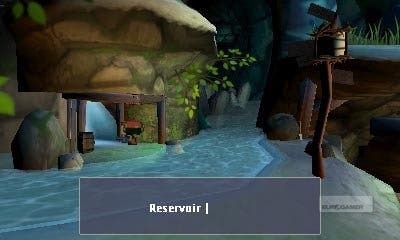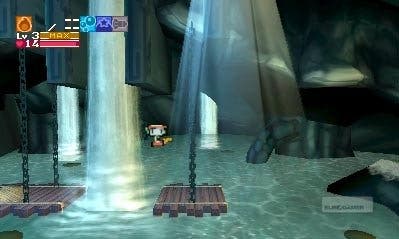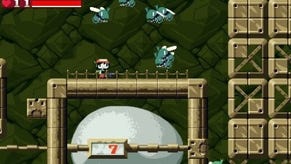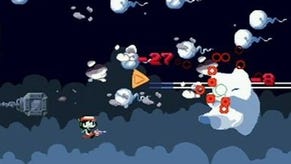Cave Story 3D Review
Chunky spelunkin'.
It took five years of work before Daisuke 'Pixel' Amaya, the sole creator of the original Cave Story, released the game as PC freeware in late 2004. It's an indie darling, a touchstone that seems to find a new audience every year, and 2010 saw its first (slightly enhanced) ports to DSiWare and WiiWare. Cave Story 3D isn't a port, though it is largely the original game: this has been visually rebuilt for 3DS, in some places expanded and in some places tweaked.
The new aesthetic comes down to taste, because the original's retro sprites still look fantastic. Cave Story 3D adds detail and depth, reimagining the characters and world in a much more rounded and solid state. It's like a chibi pop-up book, with the 3D effects used for emphasising level furniture or one-off twists - and it looks wonderful, both faithful and surprising. Certain landscapes have been reworked entirely, while favourite moments like ascending the Island's outer wall look even more breathtaking with added texture.
The audio's also been remixed, which is even more treacherous ground: the original chiptunes are amazing, with an infectious verve that recalls the very best of NES-era soundtracks (*cough* Capcom *cough*). The remix composers know what side their bread's buttered: this production sticks to layering the tunes, allowing itself an occasional flourish but keeping tightly to the original line. Updating a classic isn't easy, but aesthetically speaking Cave Story 3D hits just the right balance between homage and upgrade.

What hasn't changed is Cave Story. It proudly wears its debt to Metroid on both sleeves: most obviously in the sound effect when picking up items, and most deeply in the way its large world is structured. The areas are interlinked and branch out into alternate routes with their own discoveries, your choices leading to three possible endings and even a secret world.
Cave Story has five areas, plus several hubs and all sorts of mini-zones stashed round the edges. As you progress these environments are revisited, but always expand and in several cases change entirely. A first visit to The Egg Corridor has you running atop a row of giant incubation tanks, bulging out of the screen in 3D, and picking an intricate route through to the boss - one full of tempting but risky bonus items. On your return, much later, The Egg Corridor is a ruin, its pristine surfaces warped into dead ends and twisted routes that lead ever-onwards to new areas, new discoveries.
Rather than being a series of backgrounds for jumping and shooting, each section plays differently. Destructible blocks can be found everywhere in isolation, but only Sand Zone constructs elaborate zigzag patterns with monsters in the pockets, then lets you choose whether to clamber or blast through. It's a world that's always trying something new: underwater rapids, vertiginous ascents, expansive safe zones and cramped deathtraps. The only major flaw in Cave Story 3D is that, once or twice, it ruins a great sequence with slowdown: it's not endemic, but still lousy.

The robotic main character (you can Google his name, or earn it) is a joy to control, his floaty and steerable jump nailed down to absolutely precise controls. It's an unusual mix that suits the bespoke physics of these obstacle courses perfectly, but it's in discovering the robot's full capabilities that the controls take off.
We're talking, of course, about Big Guns: you can find and carry up to five (of 10) weapons, some of which are extremely hidden - but none are unswappable must-haves. Each cycles through three levels that are increased by collecting energy crystals dropped by enemies and decreased by taking damage.
These basic rules create a nuclear-ready arsenal that always needs a bit of maintenance. The throwing sword resembles a butter knife at level 1, but by level 3 the ghost of its former master is launching forwards and slicing up everything that looks at you funny. The Bubbler apologetically dribbles in its first form, but when levelled up an endless flurry of bubbles shoot out and can be made to whirl around you by holding the button - release it, and every one shoots forwards like a spike. There's more Nintendo homage: the fireball works exactly like Mario's, while the missiles are lovingly recreated from mother Metroid, right down to the slight inertia just after firing, and even upgrade to super missiles.
Their different characteristics - how shots move, how far they go, whether they bounce, whether they penetrate - are the key to Cave Story's pacing, where damage is more of a worry than dealing it. The enemies are arranged in large groups that harry you rather than delivering killer blows, but the trick is to whittle them down before no-frills blasting the remnants. Later nasties prove more durable, particularly flying death-bugs with invulnerable projectiles and rugby-tackling bunnies, but conserving health and weapon levels for boss fights is always the priority.

Cave Story's boss monsters shine. Recurring minion Balrog eases you in, cycling through various forms (including 'Balfrog') and receiving a kicking each time, before the latter half of Cave Story starts piling on the pain. Mental rabbits, sharks, demons, ogres, dragons, crazy scientists with multiple forms. And I just want this out there: Monster X, a gigantic death-machine on rails piloted by a cat, is a right bastard.
While the platforming tests brains and precision, the bosses are where sheer reflexes - the quickness to jump through a gap in bullet hell - come into play. By the end, they even demand resource management: one sequence pits you against three in a row, and following a few ill-judged headbanging sessions you begin approaching this gauntlet like a Rambo Scrooge.
If this was all Cave Story offered, it would merely be a great platformer. But its greatest creation is the world, a strikingly original and disturbing place. The bunny-like Mimaga and sinister Doctor are central, but around them are robots, humans, talking mushrooms, munchkins and plenty of other unidentified anthropomorphised objects. The story comes in tiny chunks and short cutaways to other characters, and though it's hardly great literature there's a surprising bleakness behind everything - and never an easy resolution.

A daft sense of humour stops things getting too suicidal: in one room, you find an entrance to the blackness framing it. Through trial-and-error, you bump through an invisible maze all around the screen, eventually reaching a dead-end and... nothing? Not so: search the ground, and claim a pair of pants belonging to another character. Useless, perhaps, but another piece of a jigsaw you'll never quite find all the pieces to.
This remake is a labour of love, and it catches the single most important thing about Cave Story. Objectively, it's a 2D game heavily inspired by Metroid. In its details, and in your hands and head, it's another world entirely.
When reading a great book you can vividly picture the events, almost like a memory, but when you play a great game it's different. Things are not so fixed. Interaction isn't just what your fingers do, but what the mind creates from hints and atmosphere: it turns an enemy into a nemesis, darkness into a ghost house, or three animation frames and a text box into the death of a friend. This is such a game, a world that invites your imagination to lose itself, and becomes so much bigger in the process.
Pixel was once asked about Cave Story's origins. "In the beginning," he answered, "I made it just to make it." You can tell.





